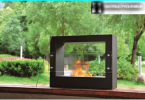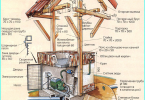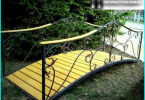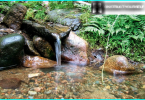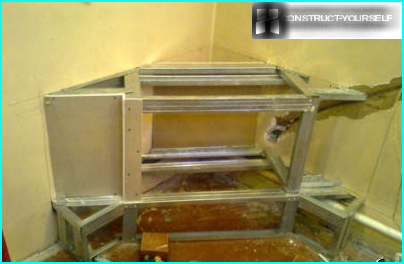
Recently dacha plots were densely planted with fruit trees and shrubs, and the remaining land is divided into neat beds. Today delight the eye not friendly rows of vegetable crops, and lawns, gazebos and swimming pools. The garden yielded its positions fancy flower beds. Suburban areas are increasingly used for recreation. While imagination shown by the owners of the land to be envied and professional designers. Take, for instance, beds of stones with his own hands built a caring gardeners. However, knowing the rules of choosing the right stone and the methods of its installation, break beautiful flower bed is not too difficult.
The contents
Choose stones for a suburban flower beds
For the device beds of natural stones in the country use different materials. Including:
- Sandstone. Enough decorative stone with many different shades of gray, yellow, brown and even red colors. Breathable, but not too durable.
- Limestone. White, grey and even cream limestone rocks have a porous structure. Cracks of these stones are filled with earth, and then improvised containers can be used for planting them plants. Algae and mosses grow well on limestone.
- Tufa (travertine). Tuff, too, is a kind of limestone. The plants are planted in the hole in the travertine, can grow beautifully weave stone. For this purpose, use ground cover plants.
- Gneiss (shale). Flat slabs of gneiss can have a very attractive green, purple or blue color.
- Granite. This stone is not often used, despite its outward attractiveness. It is able to greatly acidify the soil. Used in a small amount.
- Basalt. This awesome stone, thanks to its decorative appearance, often used for decorating and creating flower beds.
- Pebbles. Such a generalizing name given to stones of different size and color with a rounded shape. These stones turned the water and use them for beds of different types.
- Dolomite. Is a mineral and a rock, which can become a real decoration of any flower beds. Often, dolomite is used as an ornamental stone.
Typically, to create flowerbeds choose one or a few large boulders, which create an arrangement of smaller stones. Thinking about how to make the functional of a bed of stones, stored and additional materials. For drainage, the necessary sand, gravel and large rubble. Prepare for mulching tree bark, peat and fine gravel.
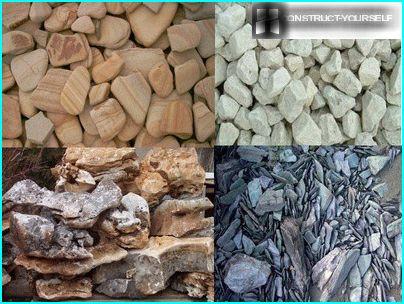
1. Sandstone – beautiful, but non-durable material; 2. the limestone has a porous structure, suitable for growing moss; 3. tuff is often used for growing groundcover plants; 4. slate is a very beautiful stone
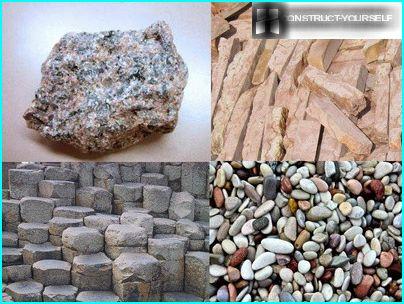
1. granite is a beautiful stone that is often used as acidify the soil; 2. dolomite is often used as an ornamental stone; 3. basalt – stone, which always looks a winner; 4. pebbles – material used not only for beds but also for paving
The overall harmony of space is achieved by adding to a bed of stones and decorative paths or reservoirs, the decorations of which also used stones. For example, pebbles or marble chips.
General rules of accommodation of a flower bed
If you build not just have a border of stones, and the whole flower bed, using stones of the same type and a similar geometry is not a prerequisite. The use of different stones, each of which will make its own accent, it might be a good find. But do not forget that the primary style in the design of the entire garden, its buildings and flower beds must be maintained.
There are General rules laying out the flower beds, which need to be considered:
- beautiful flower beds of the stones should be placed so that its presence does not interfere with, and to rejoice: for this purpose, suitable place along the wall of the house or in the Central part of the garden;
- plants need conditions for growth and flowering, so pick them should be on the basis of the same conditions of comfort, for example, fern and Vinca prefer a shaded part of the garden, and marigolds and lupins are light-loving plants;
- when Seating plants it is necessary to consider their relationship to moisture, size, and other properties;
- itself the bed should have a fairly simple form;
- easier to make one big bed than two small.
The last rule just taken note of, because less effort does not always provide the best results. The number and location of flower beds depends on the overall design of the site.
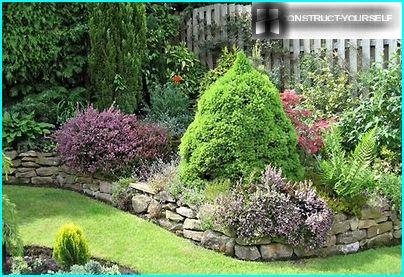
This small but colourful flowerbed near the fence, pleasantly refreshes the landscape of the site and does not interfere with the walks and leisure gardeners
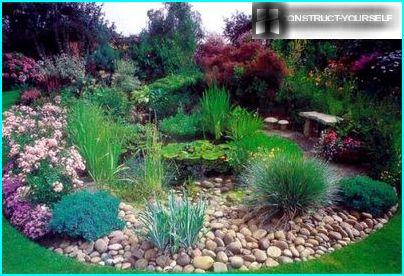
Flowerbed with stones in the center of the site forms its own area, which is quite capable of replacing, for example, the gazebo
The procedure for the device flowerbeds with fencing stones
You can certainly make an ordinary flower bed and decorate it with a border from natural stone, but more and more owners prefer to create high beds of stone. They look more solid through and through. For such structures it is necessary to lay the stones in a few levels, until the wall for flower bed reaches the desired height.
Device stone beds will have to start with the Foundation. Take the twine, pegs and note in advance the location of the flower garden. The perimeter will prokopek a trench depth of about 30 cm and a width corresponding to the size of stones that will be used. You can remove the layer of soil from the entire surface of the future flower garden.
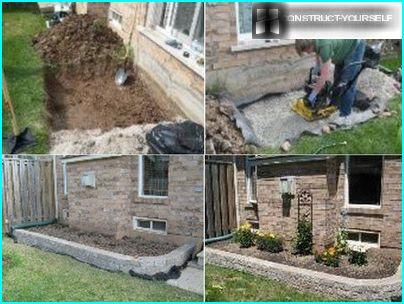
To break a bed of stones is not so difficult: you need to make a Foundation, to wait until it dries, to fill the earth and plant the plants
At the bottom of the resulting recess can put plastic or roofing felt. Now you can pour a concrete Foundation. Strengthened and prepared for the use of the Foundation will be a perfect base for stone beds. The stones should be laid on a completely dry Foundation.
To make a flower bed on a concrete base optional. If we limit groove at the perimeter of the building, you need to put it with geotextile and fill one-third with sand. On compacted sand placed the massive stones.
Natural stones are heterogeneous and valuable is the uniqueness of their sizes and shapes. But natural stones leads to the fact that it is rather difficult to adjust to each other. Gaps occur between the stones, filled with earth, which should be well beaten. Now the stones will be half peek out from the trench tightly with sand and soil. They will be the basis for the whole structure.
For further masonry can be used solution. If the bed is made of stones and cement, in the bottom layer should include drainage holes. In addition, the cement should only be used with the inner surface of the stones to the outside is preserved the effect of dry masonry.
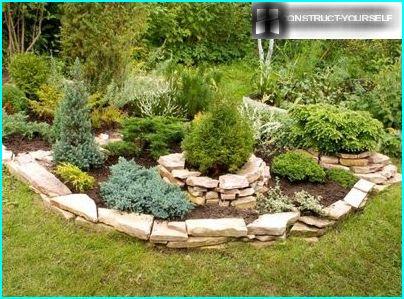
The bed does not have to be outstanding in size: even a small flower can emphasize the style of the site, to make it more comfortable
After hardening of the cement with a garden sprayer on the surface of the beds is covered with a special sealant. It will prevent the formation in the joints of the stones of all cracks. Remember that the desired degree of strength of cement mortar is reached not immediately but only after a week. That was then, and to fill the earth and plant all of the proposed plants.
If the height of the structure will not exceed 60 cm, it is possible to do without cement. The stones are placed dry method, carefully adjusting them to each other and filling the void with earth. The low design of the stones will not shatter, if you try to pick up stones in form, minimising any voids.


